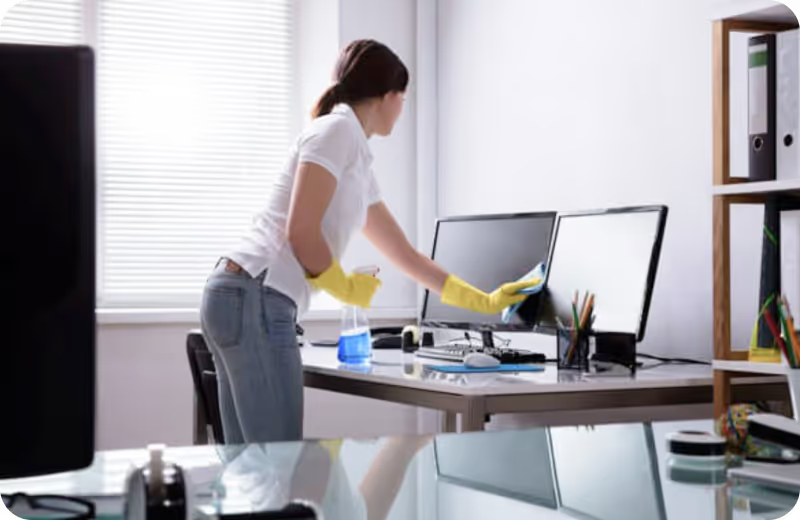
There’s something about leather that just adds a touch of luxury and elegance to any space in your home, but the catch is that it has to be properly cleaned and maintained to look its best. While leather care can seem intimidating for many people, it’s possible to clean your leather so that it looks and feels its best!
How to Clean Different Types of Leather
Smooth Finished
Smooth-finished leather encompasses leather materials that retain the entire or most of the grain layer, including the natural flaws of the animal hide. Here’s how you can clean smooth-finished leather:
- Dust Removal: Use a soft and dry cloth to carefully wipe away any dirt and debris.
- General Cleaning: Dampen a clean cloth with either a leather cleaner or some soapy water, and use this to wipe the entire surface of your leather in circular motions. Then, let it air dry, making sure to keep it away from direct sunlight or other heat sources, which can dry out the leather or cause it to fade.
Aniline
Aniline leather still retains the natural imperfections and color variations of the leather material, but it has also been dyed with aniline dyes to ensure that the colorant is distributed evenly throughout the entire leather material. Here’s how you can care for your aniline leather:
- Dust Removal: To remove dust from the surface, you can simply wipe it down with a soft and dry cloth.
- General Cleaning: Dampen a cloth with a gentle and non-alkaline soap specifically made for leather materials and wipe down the leather before letting it dry.
Semi-Aniline
Semi-aniline leather is similar to aniline leather, except for undergoing some additional processes to correct the surface imperfections as well as applying a topcoat. Follow these cleaning methods to ensure that your semi-aniline leather is in good condition:
- Dust Removal: You can give your semi-aniline leather a light dusting by wiping it down with a soft cloth.
- General Cleaning: Apply a small amount of gentle leather cleaner to a cloth and wipe it down for a more thorough general cleaning. Then, let it air dry naturally.
NuBuck
NuBuck leather is a form of aniline leather that has been lightly buffed, which raises the grain and makes it much softer and more absorbent. These cleaning methods will help keep your nubuck leather clean:
- Dust Removal: Use a soft-bristled brush to brush away any dirt or debris.
- General Cleaning: After choosing a cleaning product specifically made for nubuck leather, apply a small amount to the leather as instructed by the product. After cleaning, brush the leather in a single direction before leaving it to dry.
Suede
Unlike other forms of leather, suede leather has a hidden upside down so that the softer suede part is exposed. To keep your suede leather clean, follow these cleaning methods:
- Dust Removal: You can remove dust and debris from suede leather by gently brushing it with a soft-bristled brush.
- General Cleaning: Choose a commercial suede leather cleaner, making sure to follow the instructions printed at the back. After cleaning, use a soft brush to brush the nap of the leather in one direction before letting it air dry.
How to Remove Stains from Leather

Different leather stains need to be addressed with different cleaning methods.
- Dark Stains: If there’s a dark stain marring the finish of your leather, then create a cleaning paste by mixing equal parts lemon juice and cream of tartar. Apply this to the stain and leave it for 10 minutes. Then, apply another layer and work the cleaning paste in with a damp sponge.
- Water Stains: With a cloth dampened with some distilled water, dab at the water stain as well as the area around it. Dabbing the area beyond the water stain will prevent water rings from forming. Then, leave the area to dry. The water stain should evaporate along with the water you just applied.
- Ink Stains: Apply a small amount of lemon juice to the stained area and wait a few minutes before blotting it off. Alternatively, you can also dampen a cotton swab with some rubbing alcohol and apply it to the stain before leaving it to dry naturally.
- Mold or Mildew Growth: If you’re dealing with some nasty mold or mildew growth, combine equal parts white vinegar and water and apply this to the stain, making sure to only dampen the area. Leave it to sit for a few minutes before blotting it with a clean cloth.
- Oil Stains: Sprinkle a generous amount of baking soda on top of the oil or grease stain until the whole area is covered. Leave this for a few hours or overnight. The baking soda will slowly absorb all of the oil.
Leather Cleaning Tips: Do’s and Don’ts

DO Condition Leather After Cleaning
You should always condition your leather after each cleaning session, as this will help prevent the material from drying up and cracking. To do this, follow these steps:
- Choose a leather conditioner and apply a small amount to a clean cloth.
- Apply this to your leather in circular motions.
- Once you’ve finished covering the entire surface, leave it to soak in for a few hours or even overnight.
- Finally, use a clean cloth to buff the leather and leave it looking as good as new.
DON’T Use Too Much Force When Scrubbing
No matter how stubborn a stain may be, you should never use excessive force when cleaning your leather. Not only can this leave severe scratches and permanent damage, but it can also lead to discoloration and fading. Aside from that, harsh scrubbing can also compromise the texture and appearance of your leather by stripping the material of its natural oils.
DO Spot Test Cleaners Before Cleaning
Regardless of whether you’ve opted to use a commercial cleaner or are making your own, it’s crucial that you always spot-test these cleaners on an inconspicuous area before proceeding with the leather cleaning. This will reduce the chances of any damage, staining, or discoloration from ruining your leather material while also helping you check whether or not the cleaner is compatible with the material.
DON’T Expose Leather to Too Much Moisture
As a general rule of thumb, it’s best to use as little moisture as possible when cleaning leather, and this applies to both clean water and commercial or homemade cleaners. Using too much moisture when cleaning your leather can negatively affect the structure and texture of your leather while also encouraging the growth of mold and mildew, among many other things.
DO Brush Leather Before Cleaning
There are many reasons why you should always start each leather cleaning session by brushing down your leather with a soft brush. The main benefit is that it loosens up and removes any surface-level dirt and debris, which could actually be abrasive and leave scratches on your leather later on. It also makes your cleaner more efficient, as it will no longer have to break through that extra layer of dirt to penetrate your leather.
How to Maintain Leather

Here are some tips to help keep your leather looking and feeling its best:
- Regularly Clean Your Leather: As part of your regular household cleaning routine, make sure that you lightly dust or wipe down your leather at least once a week to ensure that there’s no dust, dirt, or debris building up on the surface. This simple but effective habit will help prolong the longevity and maintain the appearance of your leather.
- Treat Stains Immediately: It’s crucial that you take immediate action once a spill or mess lands on your leather. Not only will this prevent the liquid from damaging your leather, but it will also make the cleaning process much easier and reduce the chances of a permanent stain being left behind.
- Avoid Using Harsh Chemicals and Cleaners: Make sure that you only use gentle cleaners or cleaners that are specifically designed for leather care on your leather, as harsh chemicals and products can lead to damage and accelerate the degradation of the material. Similarly, don’t use any abrasive cleaning tools like hard-bristle brushes and scouring pads, which can also compromise the quality of the leather.
- Avoid Direct Sunlight: Keep your leather away from direct sunlight or hot temperatures, which will dry out the material and increase the chances of it drying out, cracking, or fading.
Leather cleaning and care may seem very complicated, but it doesn’t have to be. With these cleaning methods and tips, you’ll be able to keep your leather in the best condition possible while also prolonging its lifespan.









.jpg)
.jpg)
.jpg)
.jpg)













